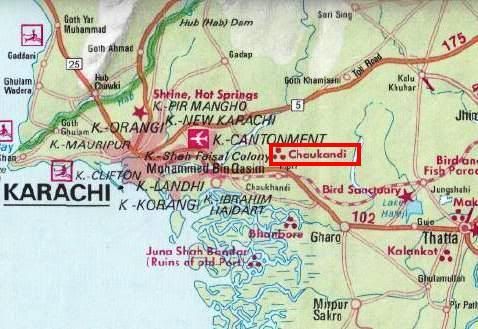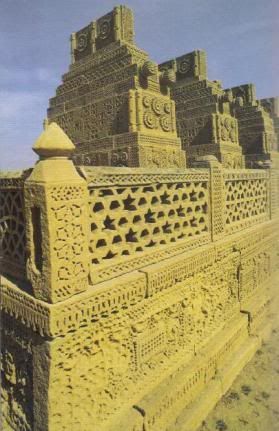This post is about the historic Chaukundi tombs located just outside Karachi. Before writing further I must admit that the last time I personally visited Chaukundi was in 1985 but I still vividly remember being fascinated by the stone carvings on these tombs. Following information comes from the tourist books and the Internet search. I’ve tried to include only the information which I could authenticate from multiple sources.

Since seeing is believing so lets start this post by watching the following video clip of Chaukundi tombs I found at the youtube.
If one travels out of Karachi on National Highway N5 – then between kilometer markers 26 and 27, towards the left side – lies an astonishing necropolis from several centuries ago called the Chaukundi Tombs.
Following map approximately shows the location of Chaukundi tombs on N5.

The word Chaukundi means ‘four-cornered’ and it got its name from the 5-star mausoleums of rich and influential people buried here and which are structurally supported by a column at each of its four sides. These columns usually support a dome or a canopy overhead the burial place. Hundreds of tombs stretch for nearly 3 kilometers. Another peculiar thing about these tombs is that they are all oriented in North-South direction.
Although a majority (of structures) consist of graves, there are some pavilion tombs supported by columns as well. Belonging to sixteenth century, the carving is similar to that found in the Samma Cluster at Makli necropolis. [source (3) below]
These tombs belong to Jokhio, Baloch and Burpat (or Burfat) tribes and most of them date back to between 13th and 17th centuries. The thing that makes these tombs stand out is the exquisitely-carved stone work. This stone work is unique to certain areas Sindh and Balochistan. Even though Chaukundi is the largest and most elaborately designed concentration of stone tombs in Pakistan, similar – but not so decorated tombs have been discovered all along the Makran coast and Lasbela in Balochistan and around River Indus delta in Sindh. In Sindh these sites include Malir, Dumlotee, Mirpur Sakro, Gujjo, Thariba, Sonda and Sehwan Sharif.
 The graves which belong to women have been decorated with stone carvings of flowers and jewelry which emphasizes the stature and wealth of the departed female. The graves of men have detailed stone carvings of horses, riders and weapons. Also included in the cluster of Chaukundi tombs are Muslim graves which tend to be unadorned.
The graves which belong to women have been decorated with stone carvings of flowers and jewelry which emphasizes the stature and wealth of the departed female. The graves of men have detailed stone carvings of horses, riders and weapons. Also included in the cluster of Chaukundi tombs are Muslim graves which tend to be unadorned.
The carving or motif which is most repeated on these tombs is a three-depth rosette which is most likely developed due to an early representation of the sun. Besides rosette, other carvings include the shapes of zigzags, flowers, crosses and diamonds.
There have been some reports of people stealing or defacing the stone carvings of these historic tombs. I’ve also heard recently that on weekend nights a local pir saayiN (Holy man) conducts services of removing ‘djinns’ from the psychologically disturbed people here. Hopefully both of these activities could be stopped from using Chaukundi tombs as their premises.
Chaukandi tombs is a protected site in the care of Department of Archaeology, Government of Pakistan.
References:
(1) Chaukhandi Tombs: Funerary Art in Sind and Balochistan, Oxford University Press 2003
(2) Insight Guide Pakistan – 2007
(3) Karachi -Illustrated City Guide by Yasmeen Lari – Oxford University Press 2000
(4) Spectrum Guide to Pakistan – 1998



















































What an excellent piece. Thank you Owais. I had the good fortune of visiting Chokundi and look at the pieces of art created by our forefathers. A very interesting feature was the pagri at the top of male tombs. I was looking at a pic of Maulana Rumi tomb in Turkey in Dr. GN Kazi flickr page when i noticed the same thing over male tombs. Perhaps a common tradition in those times.
The theft of tomb pieces are stolen by the guards of graveyard.A crook old man will chase you if you make three or four visit and offer you different prices of its carved pieces seeing the status of your car and personality.he would give you full assurance that missing pieces would be artistically replaced by same you would get this piece of heritage in drawing rooms.
It is matter of 6 years back when I got such offers and know few of my friends have taken its pieces so I am not sure how much real stones have been left in this neglected and unprotected historical piece.
Sorry, forgot to add the link for Urdu pronunciation of Khargosh. Also notice how they say other words with Khaa such as Khidmat.
Here it is.
http://www.youtube.com/watch?v=D-5TJJEnna8
@ms
It’s not good to reach conclusions so early.
I guess you have misunderstood the letters paa and kha. While Hindi has these two letters, they don’t correspond to Urdu letters phaa and khaw.
They do say Khargosh in Hindi but not in the same pronunciation as Urdu. Just listen to this story, the narrator is trying hard to use the Urdu Khaa but end up saying in Hindi accent, at 0.12 sec for example.
http://www.youtube.com/watch?v=4xkKUZTnLJQ
Also there is a problem with phir where it comes across as fir.
Also with Zaa. Hindi uses J instead of Z. Tarey Jameen Par. Is se Jyada aur kya hoga?
And of course no one can beat the Qaaf of native Urdu speakers. I guess only Persian and Arabic are the other two languages that have a distinct sound for Qaaf, right from the depth of the vocal box. Our Qabool and Qainchi is different from Kabool and Kaynchi.
Most Indian singers, especially of the new lot, also don’t have a command of correct pronunciation even though around 90% of songs are written in Urdu. Lata Ji, of course, is a gem and I’ve heard that she also learnt basic Urdu in the 1950s.
Here are Urdu alphabets for you
http://www.youtube.com/watch?v=_lO6Zmji12k
Shez is dead wrong
hindi has a P sound letter called “paa” as well as a kha letter called unimaginatively enough “kha”
in fact in hindi kha is for khargosh and p is for paani (as taught in school :))
Both these are in sanskrit as well.
Phonetically I think hindi and urdu provide a large canvas and thats why you see speakers of these languages able to pronounce correctly almost any name – while pple of say a anglo saxon , japanese, or arabic background have well known inability to pronounce certain sounds.